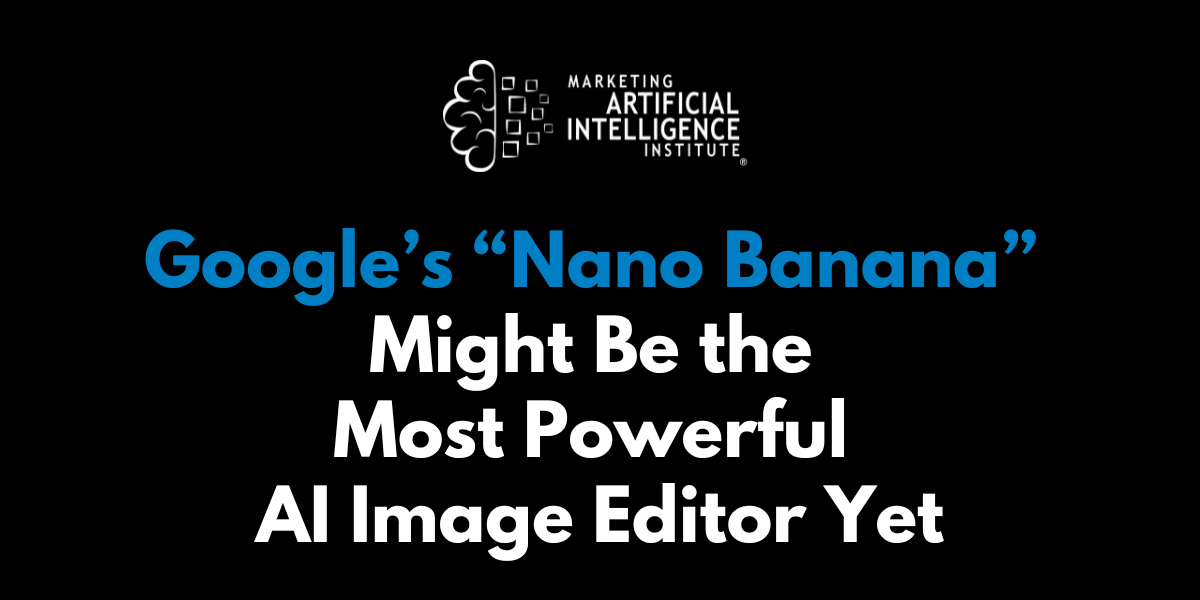Google just released Gemini 2.5 Flash Image, which is nicknamed “Nano Banana,” and some are calling it the most advanced AI image editor available today.
Built directly into the Gemini app and available via the Gemini API and Google AI Studio, Nano Banana isn’t just another image tool. It offers a seamless combination of image generation, editing, and understanding, all accessible through natural language prompts.
I unpacked what the tool can do with SmarterX and Marketing AI Institute founder and CEO Paul Roetzer on Episode 165 of The Artificial Intelligence Show.
An Image Editor That Understands the Real World
Nano Banana enables users to:
- Maintain character consistency across multiple images
- Perform complex local edits (like removing a stain or altering a pose)
- Fuse multiple images into a photorealistic scene
- Recolor or restyle photos with a sentence
- Understand diagrams and ground edits in world knowledge
While other tools might be great at aesthetics, Nano Banana goes further. It understands context. That means your dog won’t suddenly change breeds mid-edit, and your face stays your face, even if you swap the background from a kitchen to the surface of Mars.
That’s drawing a lot of attention online, says Roetzer, as users are finding the tool to be excellent at performing detailed edits using just natural language prompts.
Prompt-Based Editing Meets Multimodal Intelligence
What makes Nano Banana so disruptive is how natural it feels to use. You can say things like, "Put me on a mountaintop at sunset" or "Remove the person in the background" or even "Turn this drawing into a labeled diagram,” and it just works.
This is all made possible by the model's native world knowledge and multimodal training. They open the door to a range of new use cases, from brand asset creation to interactive educational tools.
And all images come with Google's SynthID invisible watermark, so AI edits remain traceable.
So, Is This the End of Imagen?
One of the first questions we had about the capability: Is this just Google’s Imagen 4 image generation model under a new name?
The answer: Not quite, at least according to the answers we got by asking Google Gemini.
According to Gemini, Imagen 4 is still around, but it plays a different role. It's a specialized diffusion model designed purely for photorealistic image generation from text prompts. Nano Banana, on the other hand, is a native multimodal model that understands both images and text. When it needs to generate an image from scratch, it can call upon Imagen 4 as an underlying engine.
Think of Nano Banana as the director. Imagen 4 is the cinematographer called in when needed.
Want to Try It? Just Look for the Banana
Google even embraced their playful side with this release. In the Gemini app, image editing is now symbolized by a banana emoji, a nod to the Nano Banana nickname.
It's a small touch, but it signals that Google is no longer afraid to have fun with its AI releases.
Want to explore what it can do? Ask Gemini: “Give me a prompt to test the full capabilities of 2.5 Flash Image.” You’ll get rich, detailed prompts to kickstart your experimentation. Or upload an image and ask for suggestions.
Mike Kaput
As Chief Content Officer, Mike Kaput uses content marketing, marketing strategy, and marketing technology to grow and scale traffic, leads, and revenue for Marketing AI Institute. Mike is the co-author of Marketing Artificial Intelligence: AI, Marketing and the Future of Business (Matt Holt Books, 2022). See Mike's full bio.


